The frequency of calcium oscillations induced by 5-HT, ACH, and KCl determine the contraction of smooth muscle cells of intrapulmonary bronchioles
- PMID: 15928401
- PMCID: PMC2234076
- DOI: 10.1085/jgp.200409216
The frequency of calcium oscillations induced by 5-HT, ACH, and KCl determine the contraction of smooth muscle cells of intrapulmonary bronchioles
Abstract
Increased resistance of airways or blood vessels within the lung is associated with asthma or pulmonary hypertension and results from contraction of smooth muscle cells (SMCs). To study the mechanisms regulating these contractions, we developed a mouse lung slice preparation containing bronchioles and arterioles and used phase-contrast and confocal microscopy to correlate the contractile responses with changes in [Ca(2+)](i) of the SMCs. The airways are the focus of this study. The agonists, 5-hydroxytrypamine (5-HT) and acetylcholine (ACH) induced a concentration-dependent contraction of the airways. High concentrations of KCl induced twitching of the airway SMCs but had little effect on airway size. 5-HT and ACH induced asynchronous oscillations in [Ca(2+)](i) that propagated as Ca(2+) waves within the airway SMCs. The frequency of the Ca(2+) oscillations was dependent on the agonist concentration and correlated with the extent of sustained airway contraction. In the absence of extracellular Ca(2+) or in the presence of Ni(2+), the frequency of the Ca(2+) oscillations declined and the airway relaxed. By contrast, KCl induced low frequency Ca(2+) oscillations that were associated with SMC twitching. Each KCl-induced Ca(2+) oscillation consisted of a large Ca(2+) wave that was preceded by multiple localized Ca(2+) transients. KCl-induced responses were resistant to neurotransmitter blockers but were abolished by Ni(2+) or nifedipine and the absence of extracellular Ca(2+). Caffeine abolished the contractile effects of 5-HT, ACH, and KCl. These results indicate that (a) 5-HT and ACH induce airway SMC contraction by initiating Ca(2+) oscillations, (b) KCl induces Ca(2+) transients and twitching by overloading and releasing Ca(2+) from intracellular stores, (c) a sustained, Ni(2+)-sensitive, influx of Ca(2+) mediates the refilling of stores to maintain Ca(2+) oscillations and, in turn, SMC contraction, and (d) the magnitude of sustained airway SMC contraction is regulated by the frequency of Ca(2+) oscillations.
Figures
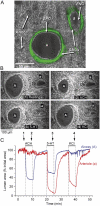

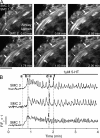



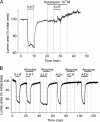


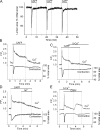

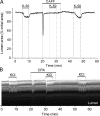

Comment in
-
Imaging dynamic cellular events in the lung.J Gen Physiol. 2005 Jun;125(6):529-30. doi: 10.1085/jgp.200509322. J Gen Physiol. 2005. PMID: 15928399 Free PMC article. No abstract available.
Similar articles
-
The contraction of smooth muscle cells of intrapulmonary arterioles is determined by the frequency of Ca2+ oscillations induced by 5-HT and KCl.J Gen Physiol. 2005 Jun;125(6):555-67. doi: 10.1085/jgp.200409217. J Gen Physiol. 2005. PMID: 15928402 Free PMC article.
-
Endothelin-induced contraction of bronchiole and pulmonary arteriole smooth muscle cells is regulated by intracellular Ca2+ oscillations and Ca2+ sensitization.Am J Physiol Lung Cell Mol Physiol. 2007 Oct;293(4):L1000-11. doi: 10.1152/ajplung.00184.2007. Epub 2007 Jul 6. Am J Physiol Lung Cell Mol Physiol. 2007. PMID: 17616645
-
Contractility and Ca2+ signaling of smooth muscle cells in different generations of mouse airways.Am J Respir Cell Mol Biol. 2007 Jan;36(1):122-30. doi: 10.1165/rcmb.2006-0036OC. Epub 2006 Aug 24. Am J Respir Cell Mol Biol. 2007. PMID: 16931808 Free PMC article.
-
Ca(2+) oscillations regulate contraction of intrapulmonary smooth muscle cells.Adv Exp Med Biol. 2010;661:77-96. doi: 10.1007/978-1-60761-500-2_5. Adv Exp Med Biol. 2010. PMID: 20204724 Review.
-
The internal calcium store in airway muscle: emptying, refilling and chloride. Possible new directions for drug development.Biochem Pharmacol. 1992 Jan 9;43(1):29-37. doi: 10.1016/0006-2952(92)90657-5. Biochem Pharmacol. 1992. PMID: 1310406 Review.
Cited by
-
Feedback via Ca²⁺-activated ion channels modulates endothelin 1 signaling in retinal arteriolar smooth muscle.Invest Ophthalmol Vis Sci. 2012 May 17;53(6):3059-66. doi: 10.1167/iovs.11-9192. Invest Ophthalmol Vis Sci. 2012. PMID: 22427579 Free PMC article.
-
High throughput screening of airway constriction in mouse lung slices.Sci Rep. 2024 Aug 29;14(1):20133. doi: 10.1038/s41598-024-71170-3. Sci Rep. 2024. PMID: 39210022 Free PMC article.
-
IL-1beta induces murine airway 5-HT2A receptor hyperresponsiveness via a non-transcriptional MAPK-dependent mechanism.Respir Res. 2007 Apr 2;8(1):29. doi: 10.1186/1465-9921-8-29. Respir Res. 2007. PMID: 17407556 Free PMC article.
-
Utilizing the Precision-Cut Lung Slice to Study the Contractile Regulation of Airway and Intrapulmonary Arterial Smooth Muscle.J Vis Exp. 2022 May 5;(183):10.3791/63932. doi: 10.3791/63932. J Vis Exp. 2022. PMID: 35604150 Free PMC article.
-
Activation of store-operated calcium entry in airway smooth muscle cells: insight from a mathematical model.PLoS One. 2013 Jul 25;8(7):e69598. doi: 10.1371/journal.pone.0069598. Print 2013. PLoS One. 2013. PMID: 23936056 Free PMC article.
References
-
- Abdullah, N.A., M. Hirata, K. Matsumoto, H. Aizawa, R. Inoue, S. Hamano, S. Ikeda, Z. Xie, N. Hara, and Y. Ito. 1994. Contraction and depolarization induced by fetal bovine serum in airway smooth muscle. Am. J. Physiol. 266:L528–L535. - PubMed
-
- Adler, A., E.A. Cowley, J.H. Bates, and D.H. Eidelman. 1998. Airway-parenchymal interdependence after airway contraction in rat lung explants. J. Appl. Physiol. 85:231–237. - PubMed
-
- Adriaensen, D., I. Brouns, J. Van Genechten, and J.P. Timmermans. 2003. Functional morphology of pulmonary neuroepithelial bodies: extremely complex airway receptors. Anat. Rec. A Discov. Mol. Cell Evol. Biol. 270:25–40. - PubMed
-
- Ay, B., Y.S. Prakash, C.M. Pabelick, and G.C. Sieck. 2004. Store-operated Ca2+ entry in porcine airway smooth muscle. Am. J. Physiol. Lung Cell. Mol. Physiol. 286:L909–L917. - PubMed
-
- Ben-Harari, R.R., A. Parent Ermini, and J. Kleinerman. 1990. Metabolism of 5-hydroxytryptophan in the isolated perfused rat lung. Pharmacology. 41:272–279. - PubMed
Publication types
MeSH terms
Substances
Grants and funding
LinkOut - more resources
Full Text Sources
Other Literature Sources
Miscellaneous

